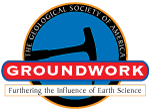Abstract View
Volume 23 Issue 4 (April/May 2013)
GSA Today
Article, pp. 60–61 | Full Text | PDF (92KB)
 |
| Search GoogleScholar for Search GSA Today |
GROUNDWORK:
How good do natural hazard assessments need to be?
1 Earth and Planetary Sciences, Northwestern University, Evanston, Illinois 60208, USA
2 Applied Mathematics, Brown University, Providence, Rhode Island 02912, USA
In trying to mitigate natural hazards, society plays a high-stakes game against nature. Often nature surprises us when an earthquake, hurricane, or flood is bigger or has greater effects than expected from detailed natural hazard assessments. In other cases, nature outsmarts us, doing great damage despite expensive mitigation measures.
These difficulties are illustrated by the March 2011 earthquake off Japan’s Tohoku coast. The earthquake was much larger than anticipated from hazard maps and generated a tsunami much larger than anticipated, which overtopped coastal defenses, causing more than 15,000 deaths and US$210 billion damage. Similar situations occur in predicting earthquake ground shaking (Stein et al., 2012), river floods (Merz, 2012), and other hazards (Pollack, 2003; Pilkey and Pilkey-Jarvis, 2007).
more …
**Jerome Stein, Professor Emeritus of Economics at Brown University, died on 8 February 2013. During a long illness, he coauthored a series of papers and a forthcoming book on integrating geosciences and economics in natural hazard mitigation.
Manuscript received 17 Nov. 2012; accepted 7 Jan. 2013
doi: 10.1130/GSATG167GW.1
